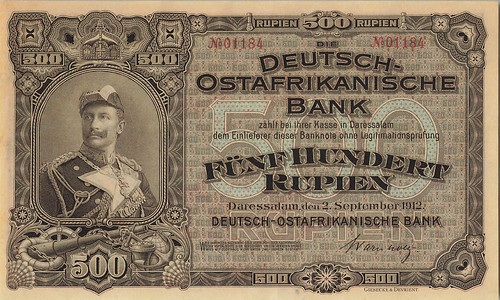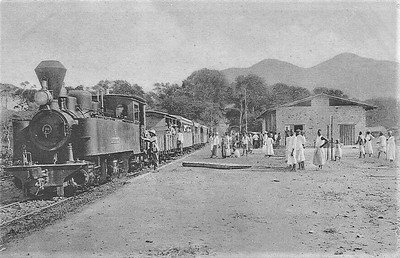
A new article on the World Banknote Auctions Blog discusses a rare German East Africa note in the firm's current sale.
-Editor

The 1912 500 Rupien issued by the Deutsch-Ostafrikanische Bank
In the first installment of our blog, we take a closer look at the 1912 500 Rupien from German East Africa, one of the classic rarities in German and African banknotes.
German East Africa 1885-1918
German East Africa was one of the most important German colonies prior to World War I, covering a large part of East Africa near Lake Victoria, including the modern countries of Tanzania, Rwanda and Burundi. Starting around 1885 the area gradually came under German control. However, the German population remained small throughout the colony's history, making up just a fraction of the population. Initial settlement was under auspices of the German East Africa Company, which focused on the cultivation of Sisal trees (used primarily in the production of rope and twine), coffee and other miscellaneous crops. It was this company which issued the first coinage for the colony in 1890. Up to that point money circulation in the region consisted primarily of Indian Rupees. The Indian Rupees were supplemented by various other European coins, such as Maria-Theresa Thalers which were minted primarily for export purposes in Europe and used throughout most of Africa.
Banknotes Introduced
The 1890 coinage series was supplemented in 1905 by a banknote series issued by the Deutsch-Ostafrikanische Bank (German East African Bank) headquartered in Dar es Salaam. The series was denominated in Rupien, the German word for Rupees. Printed by the German printer Giesecke & Devrient at their plant in Leipzig, the series initially consisted of a 5 Rupien, 10 Rupien, 50 Rupien and 100 Rupien, all dated June 15, 1905. In 1912 the series was expanded to include a 500 Rupien, dated September 2nd, 1912. The two lower denominations of this series feature local scenes, while the 50, 100 and 500 Rupien showcase two different portraits of Kaiser Wilhelm II of Germany in military uniform.

The Mombo train station in German East Africa in the early 20th century.
This banknote series saw most of its use along the coast, where most economic activities in the colony took place. The usage of the 500 Rupien was very limited, as it represented a large sum of money there was little actual need for it in circulation. As a result, official records indicate that just 696 pieces were in circulation on the eve of World War I. The series continued to be valid for circulation during the War, although they saw very limited use after the outbreak of the war. During World War I both paper money and coinage were hoarded, and most of the money in circulation during this time was emergency issues printed locally on crude paper.
Technical Details
As the largest denomination in the series, the 500 Rupien is also the largest size, measuring approximately 178 x 108 mm. This paper is what was typically used by Giesecke & Devrient at the time, and is also used for many German banknotes of this era. The watermark is a cross-star pattern. The primary design element is the portrait of Wilhelm II, with various nautical instruments and seashells placed below the portrait. The color of the note is primarily brown with a turquoise underprint. The serial numbers are found on the front in red, and on the back in black. Most of the note was printed by letterpress, while the denomination in the corners and printers imprint (found on the lower right of the front) are in intaglio.
Final Thoughts
At the end of World War I, Germany lost all of their colonies as a result of the Treaty of Versailles. German East Africa became British, with small parts of the former German colony going to Belgium and Portugal. In 1918, all currency from German East Africa was declared invalid. Today, the emergency money printed during World War II is relatively common (and a fascinating collecting area consisting of hundreds of different varieties) while the 1905-1912 issue is much more difficult to find, especially in higher grades. The 500 Rupien is the key to the series and is generally only available at auction. The majority of 500 Rupien can trace their pedigree back to a find in a German safety deposit box in the late 1980s. Most examples seen on the marketplace today have 4 digit serial numbers. While records indicate only 696 pieces were issued, it is possible more were printed, although the number must have been very small. The 500 Rupien is a classic rarity and appeals to collectors of African and European Colonial banknotes as well as historically important notes. This note should be included in every serious world paper money collection.
To view a high grade example of this issue in our next live sale, please see here:
Lot 10089: German East Africa 2.9.1912 P-5 PCGS Extremely Fine 40 500 Rupien
.
To read the complete article, see:
World Banknote Auctions Blog: German East Africa
(https://mailchi.mp/worldbanknoteauctions/rare-german-east-africa-note-offered-for-sale?e=75cd5f026b)

Wayne Homren, Editor
The Numismatic Bibliomania Society is a non-profit organization
promoting numismatic literature. See our web site at coinbooks.org.
To submit items for publication in The E-Sylum, write to the Editor
at this address: whomren@gmail.com
To subscribe go to: https://my.binhost.com/lists/listinfo/esylum
Copyright © 1998 - 2024 The Numismatic Bibliomania Society (NBS)
All Rights Reserved.
NBS Home Page
Contact the NBS webmaster
|




